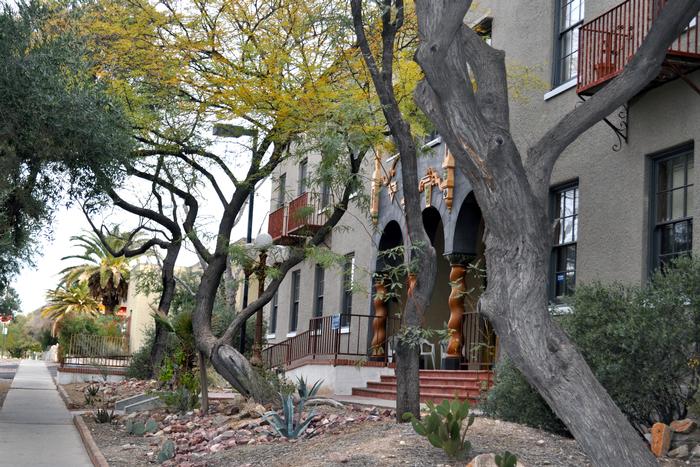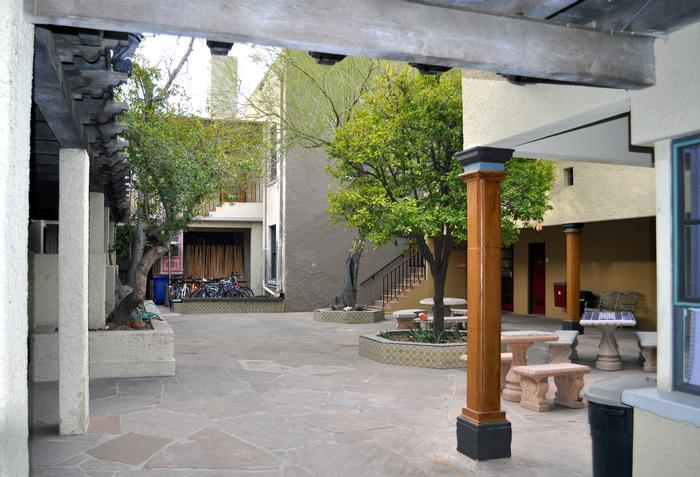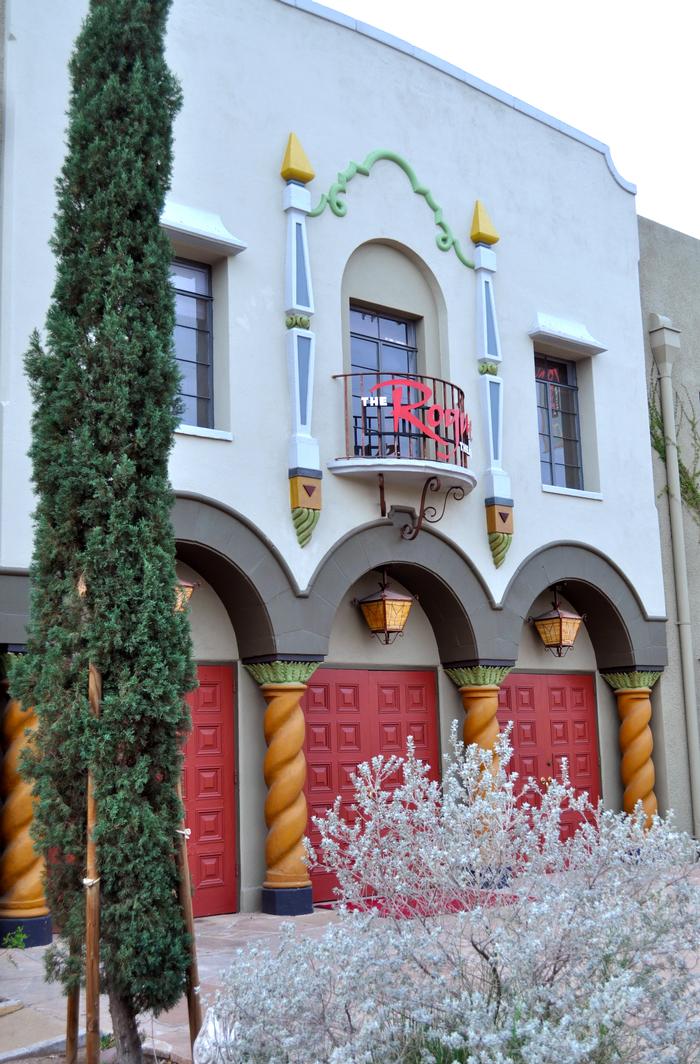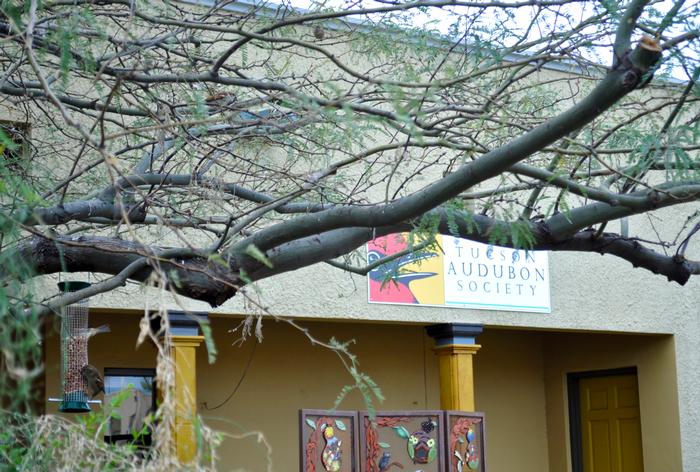Emma Survis EssayGaining IdentityTucson is a vibrant town, alive with culture both ancient and contemporary. It is a town at war with itself, wishing to be of the barrio and of the suburb, of the Hispanic culture and of the Anglo-American culture. Thus, it is a rare building that can unite this community; that can weave cultures, traditions, values, and beliefs together into one rich fabric. The Historic Y is one such place that has the strength and ability to bring together this diverse community. From the very day it was built by an extremely inspiring young woman by the name of Annie Graham Rockfellow, it has been a building for the public. The layout of the building around a large central courtyard not only reflects the design values of the southwest but also focuses on the public aspect; the importance of interaction among the users, and the creation of both planned and unexpected encounters. It is, in a sense, the essence of what Tucson was once and what it could be again. Annie Graham Rockfellow knew Tucson when it was a cultural and vibrant town alive with its Mexican past and looking to the future with the establishment of the university. Luckily for her, she didn’t see the devastation of the town she once knew. Originally, as the Historic Y was built as a YWCA for the young women of Tucson, Rockfellow no doubt felt a special propensity for it. For in this building, she built a haven for small town women coming to the city, women maybe not as brave and worldly as she was. A remarkable young woman herself, she had much more freedom and drive than was expected of a woman at her time. The first woman to enroll and graduate from the MIT architecture program, she was faced with both resentment and with respect (Tucson Historic Preservation). Though faced with adversity throughout her career from contractors not wanting to work with a female architect, to long-time clients of a firm being wary of their designs coming from a female architect, she persevered, and as evidenced by the Historic Y, she prevailed in creating worthwhile and important buildings (Regan). She designed this public building in the style of Spanish Revival, not because she was sentimental, but because she recognized the importance of not only the style in its look, but in how it was constructed. Thick adobe walls, an interior courtyard, and plenty of vegetation are important when designing in the Tucson environment to protect from the heat. This understanding of southwestern design made this building into what it is today. It is environmentally effective in this region and that no doubt had a hand in its survival through the years. In fact, this building by Rockfellow is one of the few that still exists today which speaks volumes not only for its vernacular design but also for the importance it has for the Tucson community. Even her most famous of buildings, the El Conquistador Hotel was demolished during Tucson’s darkest of days (Regan).Nearly the entire barrio of Tucson was torn down to make way for the “Tucson Community Center,” consisting mostly of parking lots and shopping malls. This “community center” has destroyed almost all of the old town of Tucson, and turned Tucson’s downtown into a veritable ghost town. Yet the Historic Y still stands today and is still used in much the same way as it was conceived: as a gathering place for people to come together, to be together. Once just for young women, it is now for a diverse community that needs such a place in order to affect the possibility of not only understanding one another but respecting one another and developing a richer community based on a wealth of ideas. Today, it is home to architectural professionals, community service organizations, preforming arts groups, farmer’s markets, and classes. Primarily notable about the architecture of the Historic Y is its strong connection to the street. Set back from the sidewalk about twelve feet, there is not empty desert dirt stretching from a cold cement sidewalk to the rugged and unappealing foundation of a building, instead there is a rich desert habitat. Large shade trees stretch up and over the sidewalk from either side and benches rest beneath the soft filtered light of the trees. Small desert shrubs and rainwater fountains dot the landscape. Outside the Audubon Society is an even more lush desert garden alive with birds both common and rare that are drawn to the delicate ecosystem created by the Historic Y. This environment makes the building not simply an object in space but one that creates space. The streetscape of this building is without a doubt one of the best in Tucson but the architecture provides the focal point of this desert garden tapestry. These gardens, along with that of the central courtyard, are also key elements in the environmental impact of this building. Trees and other plants are exceedingly important elements to the successful desert building as they provide much needed shade and moisture. Furthermore, the walls are built of white-washed adobe, forming thick thermal masses that help to regulate the temperature swing of the Sonoran Desert. The courtyard is essential for bringing in light and fresh air to every space in the building. Plus, with the courtyard, every room in the building has direct access to the outside making them much more vibrant, comfortable spaces, as well as promoting interaction between the tenants and the public. Conversations are inevitable for there is a constant stream of activity at the Historic Y. It has an intensity and energy that could not be found in an environment with less activity. Were the architecture not so open and inviting in its compilation of indoor and outdoor spaces, this would not be the case. Thus, we see that the architecture is what truly makes this building such an animated community space. Tenants, passerby, customers, students, teachers, environmentalists, architects, food enthusiasts, thespians, dancers, everyone belongs here. It is an intoxicating building that exists so wholly on its street corner, it is impossible not to be drawn in. Public spaces such as the Historic Y are undeniably important, for they provide learning opportunities comparable to a university setting. While not regimented and organized specifically as a learning annex, the Historic Y brings together people that would most probably never meet. What need does a farmer’s market have for an architect? Or an aerobics class for the Audubon Society? Yet, this is the kind of interaction that is essential to bringing a community together and creating a city that works on several levels. Successful communities must work as an integrated entity as epitomized by this building. It must be accessible to everyone, not just a specific group. It must provide the facilities and the opportunities for each and every person to excel, to learn, and to grow. Most importantly, it must provide these opportunities in a way that doesn’t give greater weight to one group more than another. For without the architect, we have no building. Without the farmer’s market, we have no fresh food. Without the preforming arts group, we have no entertainment. And isn’t this what every community strives for? The balance of living that can only result from the understanding and incorporation of the ideas and offerings that each and every member of a community can bring to the table. The Historic Y is a beautiful example on a small scale of how a well-informed and integrated community can function. The more we understand about each member of our community, the more able we are to create a community that is beneficial to all and that recognizes the specific needs of each person. It is an excellent example of how much stronger place is, a group is when it consists of a fusion of many ideas rather than just one single idea. Tucson is a melting pot and as the Historic Y so admirably demonstrates, embracing the diversity will make the whole much stronger. A true hub of activity, there is a palpable energy to the space. This vigor is what not only draws people in but also what entices them to stay. And stay they do, in an environment, a space, a form, that effectively and efficiently invites them to stay. This building has many urban qualities that make it such an inviting and useful community space. It immediately reaches out to the casual pedestrian through its strong presence on the street corner and the calmness that seems to seep from the flourishing landscape. As one walks down the main street of University Boulevard, the first thing that catches the eye is the “Rogue Theater” sign proudly exclaiming its existence above 3 pairs of beautifully carved wooden doors. As you enter, there is a sense of old world charm: an older man hands you your reserved tickets in a personalized envelope and indicates the hors d'oeuvres to enjoy while you wait among the company of other theater goers. The theater is in the old gym of the YWCA and is filled with curtains, passionate actors, and entertained audience members. It is a somewhat small space that makes you feel very strongly that you are a part of a close knit community. The actors often come into the audience and interact with them. If you exit during the day, there is no doubt that the happy and excited sounds of birds will serenade your ear. For down the sidewalk just a bit further, the Audubon Society has a large garden along the sidewalk with multiple bird feeders and even more birds chattering about the day. Tucked back between the Audubon Society and the Rogue Theater and nearly unnoticed at first is the entrance to a beautiful central courtyard. It becomes a space that invites not only those who have space at the building but all other Tucsonans on the street to come in and rest at the quiet, shady tables. Around the corner is the main entrance to the Historic Y, complete with twisted columns and beautiful steps that are so telling of the Spanish Colonial style. The individualistic nature of each of these businesses and groups is not only allowed but encouraged, creating a clear self-expression on the exterior of the building. The Audubon Society has its garden, the Rogue Theater its flashy sign, the courtyard its elegant wrought iron gate, and each door accessed from the courtyard is likewise animated. Clearly, individualism is encouraged and embraced, which reinforces the camaraderie and companionship evident in the space. There is no forced mold to fit into, the building becomes a canvas for the individual and thus becomes at once a cohesive, collaborative space that is also personal and unique. Each tenant in the space feels free to communicate their own values and beliefs that then become intermingled with another tenant’s values and beliefs. This is what public architecture is all about, bringing people together to not only share their ideas, but hear someone else’s, and in the process, perhaps reevaluate their own. Without this interaction, knowledge and learning can become stagnant, it is up to others to challenge you and enlighten you to the possibility of other ways of thinking. This diversity is embraced by each and every tenant at the Historic Y. It is a truly social space that one can gain a completely different view and perspective on an issue simply by going to the next door. This is the kind of environment that can foster real progressive changes in the world. It encourages people to grow in entirely new ways, which alone, would never have entered their mind. It is through communication and the sharing of ideas that an individual can truly develop socially, intellectually, and personally. Though everyone is welcomed, whether a long-term tenant or someone like me who simply enjoys the atmosphere of this space, it is also a space that challenges you. A space rich with variable and passionate people creates a situation that invites discussion and debate. It is a place where your own views can be changed or where perhaps you change someone else’s. And isn’t this the reason we live in the city? To be around people who challenge us and respectfully force us to carefully evaluate why we believe the things we do. There is no greater calling for a building that serves the public than one that invokes deep thought and reflection. It is a space that brings you among people both like-minded and contrary to you and asks you not only for your respect of other views but to open yourself up to the possibility that perhaps their view may alter your own. While it may seem utopian to achieve all this through a building, it is truly the architecture that renders it capable of providing opportunities for learning, for performing, for growing, and for developing new talents and skills. The Historic Y is a community within a community. Yet the community inside the building is invigorating, life-affirming, and soulful while that of the greater Tucson community is lacking that vitality. Tucson is a multifaceted, sprawling town that needs to find a stronger sense of identity and kinship. The Historic Y is a stepping stone in that direction. The importance of community is undeniably important. Communities provide people with a feeling of safety and of belonging, much like the original YWCA did as a haven for young women. If nothing else, this building truly shows us that finding other people who share our views can instill in us a greater sense of meaning and purpose than we ever had before. But perhaps even more importantly, this building shows us how finding people who have a different view than us or perhaps even new ideals can make us stronger than ever before. There is an undeniable strength in people who come together as one regardless of what got them there in the first place. The Historic Y is made of more than just whitewashed adobe; it is made of mutual ideas and shared beliefs. It provides the background for a multitude of community events that bridge the gaps between age, culture, and religion. The Historic Y should not simply be a beacon of the importance of community, but should be used as a vehicle to inspire change. Change comes about slowly, but it comes from strong convictions and the belief that what you are doing matters. Tucson needs to find peace, to unite its intricate layers of people and beliefs. The public significance of the Historic Y is that it is a community, it represents solidarity and fellowship. It has brought people together to mature, to discover, and to bring change to Tucson as a whole. Works Cited Regan, Margaret. “Remembering Rockfellow: Although Her Name is All But Forgotten, Tucson’s First Female Architect Left Her Mark.” Tucson Weekly, January 31, 2001. Accessed December 29, 2011. http://www.weekly wire.com Tucson Historic Preservation Foundation. Accessed December 30, 2011. http://www.tucsonhistoricpreservationfoundation.org/architect/annie-graham-rockfellow-1866-1954 Additional Help and InformationAre you in need of assistance? Please email info@berkeleyprize.org. |
|




